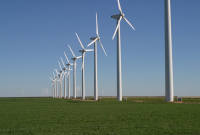Support strong Canadian climate journalism for 2025
The harsh conditions and extreme isolation of Sable Island has forced Ottawa to abandon a wind project on the iconic crescent-shaped sandbar — more than 15 years after it launched the initiative.
Parks Canada said wind turbines do not meet the needs of the wind-swept Nova Scotia island, famous for the wild horses that have roamed there since the 18th century.
"The wind turbines were part of a ... project to reduce Sable Island's dependence on fossil fuels, and were chosen based on the renewable energy technology that existed at that time," the department said in an email statement about the million-dollar, over-budget initiative.
"Since then, there have been considerable advancements in the field of renewable energy systems."
Dubbed the Graveyard of the Atlantic, some 350 vessels have wrecked on the island's shores and hidden reefs since the mid-1700s. It is home to hundreds of namesake horses that have become synonymous with its romantic and untamed image.
Environment Canada launched the pilot project in 2000 — which would have seen the five wind turbines generate energy onto the grid of the island known for its shifting sand dunes and fragile environment.
But when Parks Canada took over management of the 40-kilometre-long island when it became a national park reserve in 2013, the wind turbines were not functioning.
"The project faced several delays due to the environmental sensitivity of the site and wildlife concerns, as well as the isolated and harsh conditions," the department said, adding that the turbines were fully installed and running in 2006.
"Unfortunately, technical problems continued due to the harsh conditions and the inability to adapt the technology to the operations of the other infrastructure at the site."
The control board had also been damaged when lightning struck some of the turbines.
Sable Island, situated about 300 kilometres southeast of Halifax in the North Atlantic, has a weather station, two light stations, an airstrip and a few buildings used mainly by researchers. Canada’s first life-saving station was built there in 1801.
The island's grasslands, mud flats and sandy beaches support the world's largest congregation of breeding grey seals and several species at risk, including the vulnerable Ipswich Savannah sparrow. When it created the national park through a new law adopted in 2013, the former Harper government also sparked some controversy by working out an arrangement that would allow oil giant Exxon to pursue deep drilling for oil beneath the surface of the famous island.
First Nations leaders told Parliament that they had not been consulted on the legislation that was adopted in partnership with the former NDP Nova Scotia government of then-premier Darrell Dexter.
In 2015, the Nova Scotia government later announced it would be sending millions of dollars to Exxon to allow it to decommission its Sable Offshore Energy Project.
Meantime, the Trudeau government said it is not dumping its plans to move to renewable energy for Sable.
"Parks Canada will determine the best environmentally friendly approach to power generation based on the new reduced infrastructure footprint," said Parks Canada, who declined a request to make someone available for an interview.
Parks Canada said it hopes to develop "a reduced facility footprint, more efficient operations, reduced electricity demand, and renewable power generation" on Sable.
When asked for the total cost of the project to date, Environment Canada said just under $1 million had been spent on the project as of 2006. It will cost another $150,000 to decommission the turbines, it said.
The original budget for the wind project was $669,000.
The decommissioning will happen in two phases: The battery and switch gear were removed in 2015, and the towers and turbines are scheduled to be dismantled and removed this fall, Parks Canada said.






Comments